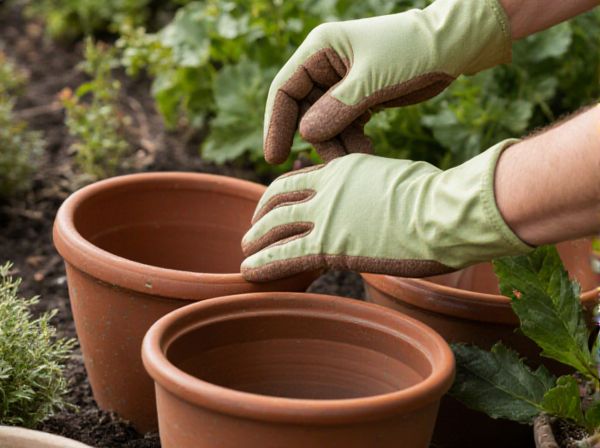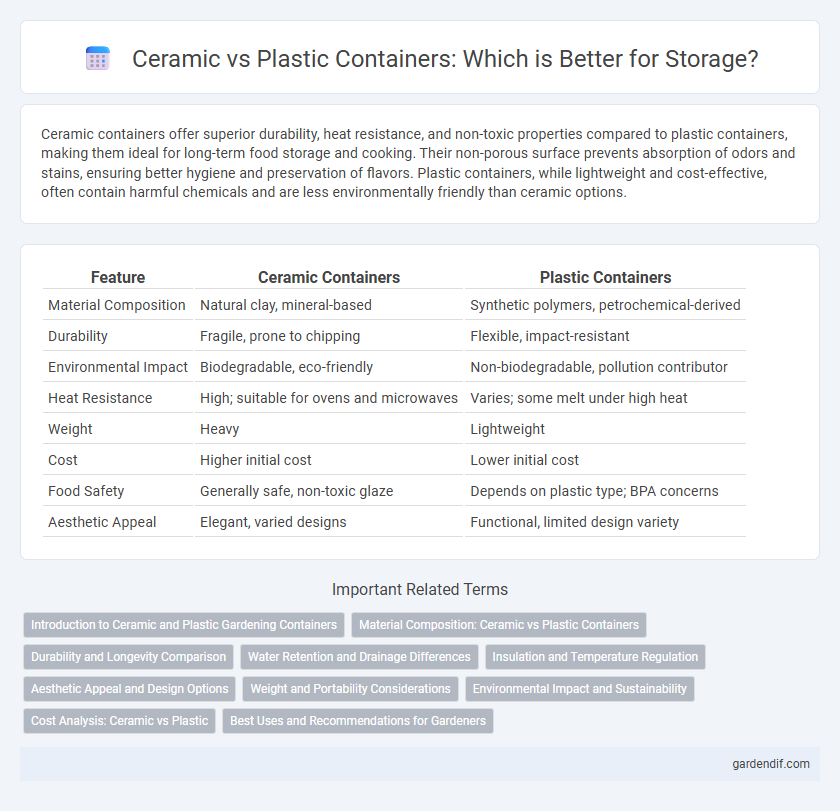
Ceramic containers vs plastic containers Illustration
Ceramic containers offer superior durability, heat resistance, and non-toxic properties compared to plastic containers, making them ideal for long-term food storage and cooking. Their non-porous surface prevents absorption of odors and stains, ensuring better hygiene and preservation of flavors. Plastic containers, while lightweight and cost-effective, often contain harmful chemicals and are less environmentally friendly than ceramic options.
Table of Comparison
| Feature | Ceramic Containers | Plastic Containers |
|---|---|---|
| Material Composition | Natural clay, mineral-based | Synthetic polymers, petrochemical-derived |
| Durability | Fragile, prone to chipping | Flexible, impact-resistant |
| Environmental Impact | Biodegradable, eco-friendly | Non-biodegradable, pollution contributor |
| Heat Resistance | High; suitable for ovens and microwaves | Varies; some melt under high heat |
| Weight | Heavy | Lightweight |
| Cost | Higher initial cost | Lower initial cost |
| Food Safety | Generally safe, non-toxic glaze | Depends on plastic type; BPA concerns |
| Aesthetic Appeal | Elegant, varied designs | Functional, limited design variety |
Introduction to Ceramic and Plastic Gardening Containers
Ceramic gardening containers offer superior breathability and aesthetic appeal, promoting healthy root growth by regulating moisture and temperature. Plastic containers stand out for their lightweight durability, resistance to cracking, and cost-effectiveness, making them ideal for both indoor and outdoor gardening. Both materials serve distinct purposes, with ceramic containers often preferred for decorative planting and plastic containers favored for versatility and ease of maintenance.
Material Composition: Ceramic vs Plastic Containers
Ceramic containers are composed of natural clay and minerals fired at high temperatures, resulting in a dense, non-porous, and heat-resistant material ideal for food storage and cooking. Plastic containers are made from synthetic polymers such as polyethylene, polypropylene, or PET, offering lightweight, flexible, and inexpensive solutions but with potential chemical leaching risks over time. The inorganic composition of ceramics provides superior durability and chemical inertness compared to the organic polymer-based plastic containers prone to degradation and environmental impact.
Durability and Longevity Comparison
Ceramic containers offer superior durability in terms of resistance to scratches and chemical leaching compared to plastic containers, which can degrade over time due to exposure to heat and UV rays. The longevity of ceramic containers is significantly higher, often lasting for decades without losing structural integrity, whereas plastic containers may become brittle and prone to cracking within a few years. Ceramic's non-porous surface prevents stains and odors, contributing to its extended usable life compared to porous and absorbent plastic materials.
Water Retention and Drainage Differences
Ceramic containers excel in water retention due to their porous structure, allowing gradual moisture absorption and evaporation that benefits plant roots by maintaining consistent hydration. Plastic containers, in contrast, are non-porous and offer superior drainage capabilities with built-in holes, preventing overwatering but often leading to quicker drying of soil. Choosing between ceramic and plastic containers depends on plant water needs and environmental conditions, with ceramics favored for moisture-loving plants and plastics suited for species requiring fast drainage.
Insulation and Temperature Regulation
Ceramic containers offer superior insulation and maintain stable temperatures longer than plastic containers due to their dense, non-porous structure, which reduces heat transfer. While plastic containers may heat up or cool down quickly, ceramics effectively regulate temperature, making them ideal for preserving both hot and cold contents. Their thermal inertia also minimizes condensation and prevents rapid temperature fluctuations, enhancing food safety and freshness.
Aesthetic Appeal and Design Options
Ceramic containers offer a sophisticated aesthetic appeal with smooth finishes, vibrant glazes, and intricate patterns that enhance home decor. Unlike plastic containers, ceramics provide a premium look and feel while allowing for diverse shapes and artisanal designs. Plastic containers prioritize functionality and variety but often lack the elegant and timeless charm found in ceramic options.
Weight and Portability Considerations
Ceramic containers are considerably heavier than plastic containers, impacting portability for everyday use and travel. The dense material of ceramics provides durability and temperature retention but limits convenience when carrying or transporting items. In contrast, plastic containers offer lightweight benefits and greater ease of handling, making them ideal for on-the-go storage solutions.
Environmental Impact and Sustainability
Ceramic containers offer superior environmental benefits over plastic containers due to their biodegradability and longer lifespan, reducing landfill waste significantly. Unlike plastic, which often contributes to pollution through microplastics and non-biodegradable residues, ceramic materials break down naturally without releasing harmful toxins. The production of ceramic containers typically involves less reliance on fossil fuels, making them a more sustainable choice for eco-conscious consumers aiming to minimize their carbon footprint.
Cost Analysis: Ceramic vs Plastic
Ceramic containers typically have a higher upfront cost compared to plastic containers due to materials and manufacturing processes but offer greater durability and longevity, reducing replacement expenses over time. Plastic containers are generally more affordable initially and lightweight, making them suitable for large-scale or short-term use, though they may degrade faster and incur higher long-term costs due to frequent replacements. When evaluating cost-effectiveness, ceramic containers provide better value for durable storage needs, while plastic containers suit budget-sensitive, disposable applications.
Best Uses and Recommendations for Gardeners
Ceramic containers offer superior breathability and temperature regulation, making them ideal for plants that require well-drained soil and moderate watering, such as succulents and herbs. Plastic containers provide lightweight durability and retain moisture longer, perfect for seedlings, indoor plants, and gardeners needing easy portability. For optimal gardening success, use ceramic pots for drought-tolerant and mature plants, while plastic containers excel in seed-starting and moisture-sensitive species.
Ceramic containers vs plastic containers Infographic

 gardendif.com
gardendif.com